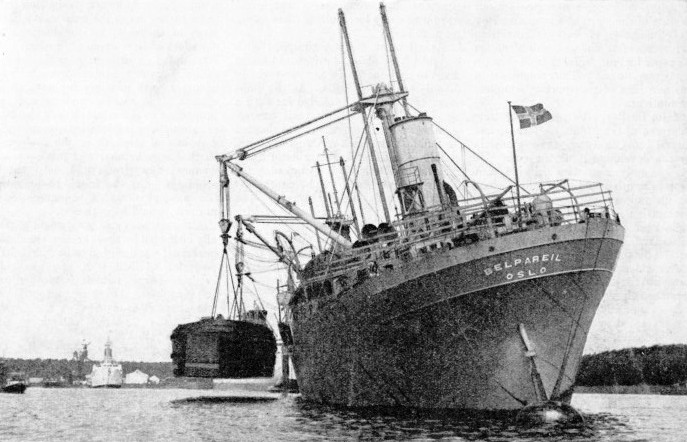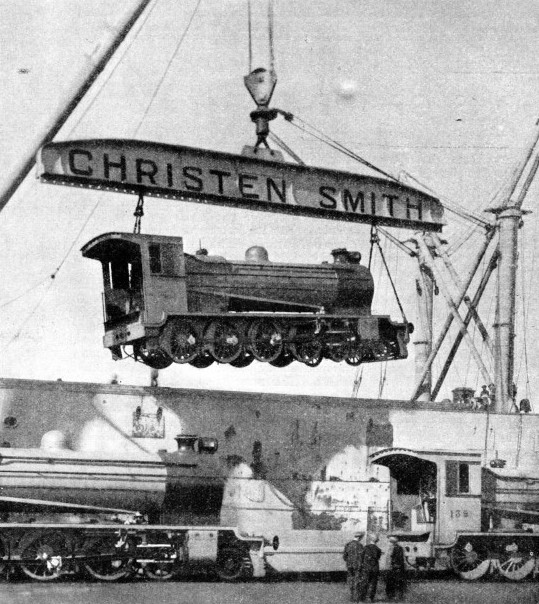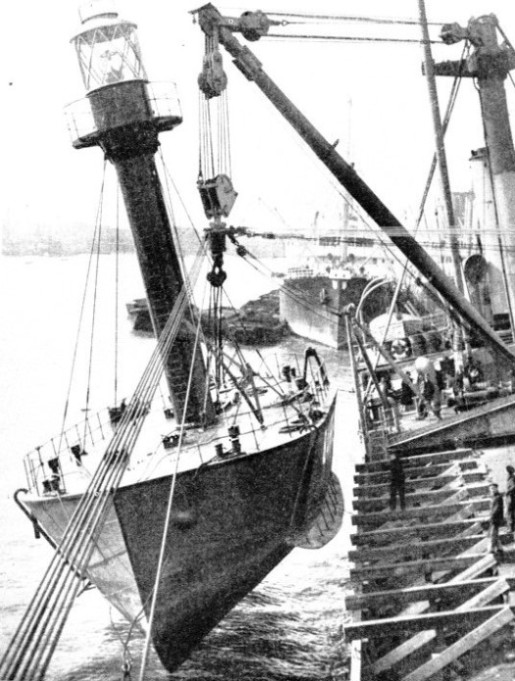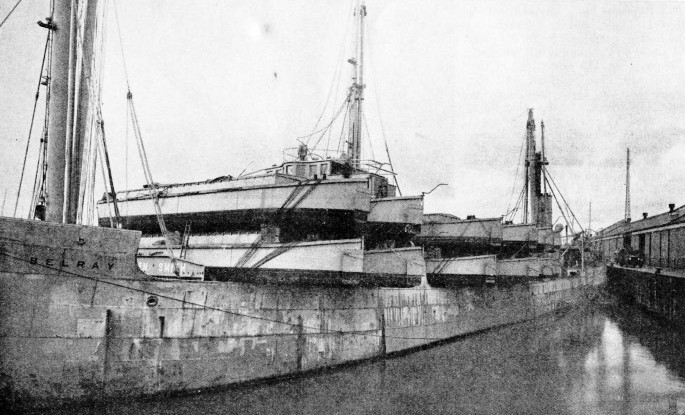

© Shipping Wonders of the World 2012-

Samsons of the Sea
The Belships have been specially designed and constructed for taking on board any cargo that is too heavy or too bulky for the ordinary cargo ship to manage
ROMANCE OF THE TRADE ROUTES -

LIFTING 200 TONS ABOARD. The Belpareil at Schiedam (near Rotterdam) in 1931, taking on board, by means of her own derricks, a hopper barge weighing 200 tons. This was the heaviest weight ever lifted by a vessel afloat, and gave the Belpareil a heavy list until it was on deck.
SOME ships must be designed to carry queer cargoes in the course of their duties. Sometimes a complete tug has to be carried half across the world. Occasionally a complete railway, consisting of locomotives, coaches and rails, has to be taken to some out-
As a general rule any of the larger vessels in the carrying trade will make shift to deal with such a cargo; but only one line, Belships Co., Ltd., has made a speciality of such work and produced ships for it. These vessels are the Samsons of the sea. In addition to carrying heavy and awkward cargo, they can with their own gear lift a load such as a lightship or a heavy tug out of the water on to their own decks. Secured there, such cargo may travel to its destination; at the end of the voyage it can be lifted off again.
Belships had their origin in the years following the war of 1914-
A Tyneside, firm specializing in the building of locomotives was faced with the problem of shipping 200 of them overseas, and wished to do so with as little disturbance as possible to the completed vehicle. It had hitherto been the custom to dismantle a locomotive, removing the boiler and cab from the frame and stowing the boiler in the ship’s hold. All this meant extra work and cost.
Captain Christen Smith, a Norwegian shipowner with experience in the Norwegian Navy, had often dealt with the problem of lifting heavy weights from the water and stowing them on the decks of ships. He got into touch with the locomotive builders. Captain Christen Smith had invaluable knowledge not only of the lifting of weights and the rigging of derricks and winches, but also of the stowing of such weights once they were on board so as not to upset the stability of the ship. He cooperated with the locomotive builders to convert two existing cargo ships. These vessels were of a type known among seamen as “three-
When these two converted ships had successfully transported the locomotives, Captain Smith began to look round for other cargoes for which he could employ his ships. Although a sum greater than the cost of the ships had been saved by the elimination of heavy dismantling and re-
Major Shelley, who was at the time Chairman of the Bombay, Baroda, and Central India Railway, was responsible for the development of the idea. He was the only man who believed that Captain Smith could ship rolling stock for his railway and save the cost of dismantling. Captain Smith went to India and showed the Bombay port authorities his plans for a new ship capable of landing complete locomotives.
The existing “three-
A complicated conversion problem was presented by these ships, with their small hatches, limited deck space and holds obstructed by many stiffening web frames, bulkheads and pillars. The requirements were large hatches capable of taking a complete railway coach, holds free of obstruction and exceptionally strong decks and hatch covers to carry locomotives when taken as deck cargo.
As all ports are not equipped with weight-
The First Belship
The first Belship was built for the makers of the locomotives by Sir W. G. Armstrong Whitworth & Co., Ltd., whose Tyne shipyard was near the locomotive works.
The ship was given the following special characteristics: wide, clear holds with as few bulkheads as the strength of the hull and classification societies would permit; a single deck extending fore and aft with the machinery right aft so that the hold space was not broken up by an engine-
Although heavy cargoes would generally be loaded by shore cranes, the ship’s gear itself was designed to be sufficiently powerful to deal with any available cargoes -
Above all, ample stability was not sacrificed, for many of the loads would have to be lifted from the water, causing the ship to tilt over considerably. A good maximum speed with the heaviest of deck loads and with holds not necessarily full, was another feature included in the design.

LOADING LOCOMOTIVES. Before the Belships were designed by Captain Christen Smith, locomotives had to be completely dismantled before it was possible to load them in cargo ships for export. This picture shows the motor ship Belpareil (7,203 tons gross) lifting a complete locomotive on board with her own derricks.
The first of the Belships, the Beldis, completed in 1924, was a small ship, for she had to enter ports inaccessible to larger ships of the 12,000-
The chart house was a plain, workmanlike affair with a telemotor control wheel for the steam steering gear, a standard compass and an engine-
The Beldis proved an undoubted success and caused some liner companies to bring their own fleets up to date. She was soon followed by other ships of similar type. Two of them, the Belpareil and the Beljeanne, completed in July and August 1926 respectively, were specially constructed to handle bigger and heavier cargoes. They are twin-
The Beljeanne has a service speed of about 11 knots, and her draught in fully-
The Belmoira and the Belpamela are slightly smaller. They were completed in February 1928, and have a deadweight capacity of 4,375 tons and a gross capacity of 3,215 tons, with an overall length of 329 ft. 7 in, a beam of 49 ft. 3 in. and a depth of 21 ft. 3 in. Although larger than the pioneer Beldis, they have the same sized engines of 1,350 b.h.p. on single screws. Their speed is about 10 knots when loaded to 19 ft. 9½ in., and their oil consumption is similar to that of the Beldis. The Belnor and the Belray, finished respectively in January and May 1926, have other slight variations, but the main engines throughout the fleet are standard, whether on single or twin screws. Thus engineers familiar with the engines of one vessel can deal confidently with those of any of the others.

ONE SHIP CARRIES ANOTHER. The Belmoira is seen in this photograph in the Thames off Woolwich lifting on board a complete lightship. The lightship is the Bahrein, and was shipped to Basrah for the Royal Indian Marine (now the Royal Indian Navy). Apart from the weight of the lightship (120 tons), its awkward shape presents difficulties with which ordinary stevedore methods could not cope. Expert mathematicians solve the problems of the disposition of weight for cargoes of this nature.
This interesting fleet is Norwegian-
The directors watch for big engineering contracts overseas that involve the shipment of a great deal of engineering material from Great Britain or any European country. As soon as a contract has been placed, a representative submits a proposition for the transport of heavy material. Armed with information about sizes and weights, he then “loads” his ship on paper and calculates a freight rate for the carriage. Loading heavy cargoes in ships of this kind is no ordinary matter and intricate calculation is necessary to decide how the heavy derricks are to be arranged and exactly how the ship is to be ballasted when lifting, say, a complete tug out of a dock on to the deck.
The total cargo may consist of a hold full of railway coaches for Argentina, with the after deck loaded with locomotives on the hatch covers, and a tug and some barges on the forward deck. Such loads may overhang the deck edge as much as six feet on either side. Any odd space remaining on board is filled with compact and heavy items. Not only is such a cargo a mixed one, but also the distribution of weights is a matter for the most, expert of mathematicians and beyond the competence of stevedores.
Business scatters the ships all over the world, first with their cargoes and then in search of cargoes to bring back. One Belship, for instance, went from Manchester to Karachi and then in ballast from Karachi to Vancouver via the Cape and Panama to bring home a cargo of lumber.
Belships laden with pipes for an oil pipe line may be seen ploughing their way through a Biscay gale, or they may go up the Thames to discharge Canadian and American lumber at the Surrey Docks. On occasion they may be found under grain elevators in some of the smaller British coastal ports. Never pretty, they are always utilitarian, and seldom has it been necessary to lay them up through lack of work.
Many interesting cargoes have been carried by these ships. The Belpareil, in 1936, loaded ten complete locomotives and tenders at Liverpool. She called at Antwerp and picked up ten more locomotives and tenders and twenty-
Resourceful Improvisation
On one occasion the Belnor had to land railway rolling stock at Wu Hu, which is two days’ journey up the Yangtze Kiang, in China. There was not even a landing-
The problem of unloading the rolling stock was solved in a novel and ingenious manner. The Chinese securely moored three barges to piles sunk in the river bank. Beams were laid over the barges and railway lines were run across the beams. The Belnor lifted locomotives and coaches from her deck with her own derricks and laid them on the rails. Four hundred coolies hauled the coaches ashore. Weights carried by the Belships are remarkable. On one voyage to India the Belpareil had in her holds nine locomotives and nineteen tenders. Each locomotive weighed 85 tons and each tender 30 tons. On the Belpareil’s deck were three hopper barges, each weighing 195 tons, a coal barge (50 tons), a launch (6 tons), two tugs and 150 tons of steel piping. On homeward journeys the Belships generally carry ordinary bulk cargoes.
Belships are tramps in every sense of the word and in an age of specialization they are specialists. Careful organization alone gets them outward cargoes, although competition is not fierce. For homeward cargoes they must compete in the open market against ordinary tramps in the bulk trades (grain and ore) and in the lumber business.
The conception of the fleet was daring. As with nearly all new ideas, deep-

THE CARGO IS WIDER THAN THE SHIP. This photograph shows how barges may be safely loaded in the specially constructed Belships. The Belray (2,888 tons gross) is seen here leaving Liverpool for India with twelve barges loaded across her forward deck. The barges project beyond the edge of the deck for six feet on either side.
You can read more on “The Beljeanne”, “The Marwarri” and “The Hyogo Maru” on this website.